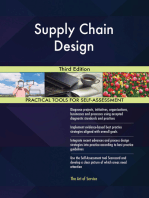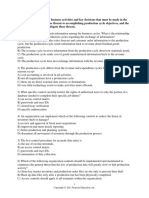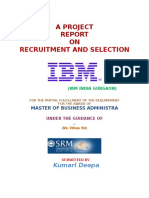BSCM PracticeQuestions 2009
BSCM PracticeQuestions 2009
Uploaded by
Laercio Do Vale Jr.Copyright:
Available Formats
BSCM PracticeQuestions 2009
BSCM PracticeQuestions 2009
Uploaded by
Laercio Do Vale Jr.Original Title
Copyright
Available Formats
Share this document
Did you find this document useful?
Is this content inappropriate?
Copyright:
Available Formats
BSCM PracticeQuestions 2009
BSCM PracticeQuestions 2009
Uploaded by
Laercio Do Vale Jr.Copyright:
Available Formats
APICS acknowledges the Basics of Supply Chain Management Committee for its contributions in the development of this resource.
Jim Caruso, CPIM, CSCP (chair) Carol Bulfer, CPIM James F. Cox, Ph.D., CFPIM, CIRM, Jonahs Jonah William Leedale, CFPIM, CIRM, CSCP Michael A. Roman, CPIM Angel A. Sosa, CFPIM
2009 APICS The Association for Operations Management No part of this publication covered by the copyright herein may be reproduced or copied in any form or by any means without the written permission of the publisher. APICS The Association for Operations Management 8430 West Bryn Mawr Avenue Suite 1000 Chicago, IL 60631 Phone: +1 800-444-2742 or +1 773-867-1777 Fax: +1 773-639-3009 Stock #09205, 01/09
Important Information Regarding these Practice Questions One important way to prepare for the APICS CPIM examinations is to simulate the test experience by taking a series of practice questions. One of the benefits of using the practice questions is familiarizing yourself with the types of questions encountered in an actual APICS certification examination. There is no correlation between the number of practice questions you answer correctly and your success under actual examination conditions, but your understanding of typical question formats can make the actual examination less stressful. Please be aware that these practice questions have been retired from previous examinations. In most cases, the questions had been used an optimal number of times and were replaced by questions that had enjoyed less exposure. For this reason, the questions may not have been developed using the references currently cited in the APICS Examination Content Manual as primary or additional references. The questions themselves have been reviewed for currency by the appropriate committee of the APICS Curricula and Certification Council. The practice questions in this publication have been selected to represent the topical distribution of the questions that you can expect to encounter in the examination. To assist you in a general understanding of how test questions are related to the reference materials used in their creation, the answer key provides the page numbers of the source reference material. However, unless they are identified in the current Examination Content Manual, do not assume that the references listed in this publication are appropriate for use as study materials. For more information about the APICS CPIM examinations, please visit the Certification section of the APICS website (www.apics.org).
Basics of Supply Chain Management Practice Questions | 1
Basics of Supply Chain Management Practice Questions
1. Which of the following demand fulfillment approaches typically provides the longest delivery time? (A) (B) (C) (D) engineer-to-order make-to-order assemble-to-order make-to-stock
2. Which of the following is generally a characteristic of a product-focused layout? (A) (B) (C) (D) large queues at workstations fixed flow of work production to a work order general purpose workstations
3. Which of the following is generally a function of the physical distribution system? (A) (B) (C) (D) production activity control production planning packaging bill of material
4. A forecast is typically more accurate for (A) (B) (C) (D) groups of items rather than for individual items daily rather than monthly periods of time physical units rather than monetary units far out in the future rather than nearer time periods
5. Which of the following is most likely to be a dependent demand item? (A) (B) (C) (D) a manufactured subassembly an item in a grocery store a service part an office supply item
6. Which of the following represents the pace of production synchronized with the rate of sales? (A) (B) (C) (D) poka-yoke takt continuous flow production leveling
Item 7 is based on the following data. Beginning inventory = 200 units Ending inventory = 200 units Sales forecast: Month 1 2 3 Quantity 200 300 200
4 400
5 300
2 | Basics of Supply Chain Management Practice Questions
7. What is the required monthly production to achieve level production? (A) (B) (C) (D) 220 units 240 units 280 units 340 units
8. A lean production 5S system is designed to (A) (B) (C) (D) recycle discover defects identify work method deviations create a visual workplace
Items 9 and 10 are based on the following indented bill of material. Level 0 1 2 2 1 1 Part A B C E C G Quantity per not applicable 2 2 2 4 4
9. How many units of part C are required to produce one unit of part A? (A) (B) (C) (D) 2 4 6 8
10. Which of the items in the bill of material are parents? (A) (B) (C) (D) A only B, C, and G only A and B only A, B, C, and G only
11. The setup time for an operation is two hours and the run time is 10 minutes per piece. The scheduled operation time for 100 units is (A) (B) (C) (D) 130 minutes 1,000 minutes 1,100 minutes 1,120 minutes
12. Material requirements planning (MRP) schedules a planned order receipt when (A) (B) (C) (D) a gross requirement exists a net requirement exists an exception is generated safety stock is zero
13. Daily operating time divided by required quantity per day is a calculation of which of the following? (A) (B) (C) (D) cycle time process time takt time lead time
Basics of Supply Chain Management Practice Questions | 3
14. A purpose of holding extra inventory is to (A) (B) (C) (D) allow production to select what to run minimize the bill of material levels reduce the number of purchased items buffer production from demand variation
15. Which of the following provides a buffer for seasonal demand? (A) (B) (C) (D) lot-size inventory fluctuation inventory anticipation inventory decoupling inventory
16. Owners equity is (A) (B) (C) (D) revenue less liabilities revenue less expenses assets less liabilities assets less expenses
Item 17 is based on the following data. Sales = $16 million Cost of goods sold = $10 million General and administrative expenses = $4 million Average inventory = $2.5 million 17. The inventory turnover ratio is (A) (B) (C) (D) 1.5 1.6 4.0 6.4
18. An item has a lead time of six weeks and an average demand of 150 units per week. The safety stock for the item is 300 units and the order quantity is 2,000 units. The order point for the item is (A) (B) (C) (D) 300 units 900 units 1,200 units 2,000 units
19. Which of the following is most consistent with ABC analysis and control? (A) (B) (C) (D) All items should have the same level of control. A small number of items account for a large portion of annual usage value. Items need tight control. Perpetual inventory records are required for all items.
20. In a decentralized distribution system, the role of the central supply is to (A) (B) (C) (D) determine when to replenish stock at the distribution centers respond to demands from the distribution centers coordinate communications among distribution centers forecast demand at each distribution center
4 | Basics of Supply Chain Management Practice Questions
21. The primary purpose of a cycle count program is to (A) (B) (C) (D) correct inventory errors result in fewer counts per year require less skilled counters identify causes of inventory errors
22. What should an effective poka-yoke do? (A) (B) (C) (D) inspect 100 percent of items perform statistical process control randomly inspect incoming parts inspect 50 percent of items
23. In the Toyota Production System, which of the following concepts was key to breaking down the silos that cripple an organization? (A) (B) (C) (D) the cross-functional structure matrix cross-functional training the control department concept kanban
Item 24 is based on the following data. Periods: Forecast: Actual demand: 1 20 22 2 20 18 3 30 25 4 20 20 5 25 19
24. The mean absolute deviation (MAD) for the data given is (A) (B) (C) (D) 2.2 3 11 15
25. In the Toyota Production System (lean), which statement best describes the planning process? (A) A separate planning department comprised of forecasting and marketing experts continually assesses and reassesses marketing trends to respond effectively to new customers needs. (B) Significant data is collected and mined to determine trends and how to respond as a company to results of econometrics models. (C) An extension of MBO, which focuses on objectives and process, long- to short-term plan-docheck-act cycles, consensus building and alignment, catch ball, and people focus. (D) ERP and supply chain software collects the data for analysis, the planning department analyzes the data, top management analyze the results and develop a plan, which is reviewed by key workers. 26. Which of the following statements is correct? (A) (B) (C) (D) The lot size affects the product mix cycle. The stock out ratio frequently depends on the lot size quantity. The lot size always should be equal to one. The EOQ is the best method to calculate the lot size.
27. A primary advantage of electronic data interchange (EDI) with suppliers is that it (A) (B) (C) (D) reduces paperwork bypasses the buyer employs the latest technology supports unlimited forms of communications
Basics of Supply Chain Management Practice Questions | 5
28. In most cases, the fastest way to increase capacity to meet a short-term requirement is to (A) (B) (C) (D) hire additional workers use overtime acquire more equipment subcontract work
29. The demand at a workstation in a lean system typically comes from (A) (B) (C) (D) a pull signal a dispatch list the production plan a control chart
30. Which of the following best describes a kanban system? (A) (B) (C) (D) a quality control system push production requires operator flexibility visual reorder point
31. The master production schedule (MPS) is (A) (B) (C) (D) an anticipated build schedule an input to the production plan a statement of forecast demand driven by material requirements planning
32. The balance sheet for a firm shows which of the following? (A) (B) (C) (D) profit or loss for the period sources and uses of funds long- and short-term debt cost of products sold
Item 33 is based on the following data. Month 1 2 3 4 Projection 100 100 100 100 Demand 95 102 105 98
5 100 102
6 100 103
Total 600 605
33. The projection for the seventh month using a three-month moving average would be (A) (B) (C) (D) 100 101 103 105
34. Which of the following is an advantage of a decentralized distribution center? (A) (B) (C) (D) easy coordination between distribution centers does not react quickly to local demand reduce coordination and communication expenses reduce the system safety stock
35. Which of the following costs are associated with variable transportation cost? (A) (B) (C) (D) pickup and delivery terminal handling line haul costs billing costs
6 | Basics of Supply Chain Management Practice Questions
36. Which of the following detects bias in a forecast model? (A) (B) (C) (D) tracking signal mean absolute deviation (MAD) demand filter standard deviation
Item 37 is based on the following data. On-hand 100 Week Forecast Projected Avail. MPS Receipts
1 200
2 200 300
3 200 300
4 200 300
37. The projected available at the end of Week 4 is (A) (B) (C) (D) zero units 100 units 200 units 300 units
38. Which of the following is the most likely impact of doubling the ordering costs for an item? (A) (B) (C) (D) The order quantity will increase. The order point will increase. The order quantity will decrease. The order point will decrease.
39. Work-in-process inventory serves to decouple which of the following? (A) (B) (C) (D) production from suppliers finished good inventory from customer demand an operation from succeeding operations production from distribution channels
40. Which of the following defines the sequence of operations to be performed to manufacture a part? (A) (B) (C) (D) item master bill of material routing shop calendar
Items 41 and 42 are based on the following information for a single work center. Number of machines = 4 Number of shifts = 1 Shift length = 40 hours Efficiency = 90% Utilization = 90% Actual output Week 1 = 160 hours Week 2 = 140 hours Week 3 = 150 hours Week 4 = 150 hours
41. Which of the following is the rated capacity for the work center? (A) (B) (C) (D) 130 hours 144 hours 150 hours 160 hours
Basics of Supply Chain Management Practice Questions | 7
42. Which of the following is the demonstrated capacity for the work center? (A) (B) (C) (D) 130 hours 144 hours 150 hours 160 hours
43. Which of the following is used to manage queues and lead times? (A) (B) (C) (D) forward scheduling rough-cut capacity planning material requirements planning input/output control
44. Which of the following is used to rank the frequency of problems? (A) (B) (C) (D) Pareto analysis cause-and-effect diagram process flow diagram root cause analysis
45. Driver costs usually appear as what type of transportation cost? (A) (B) (C) (D) fixed transportation cost burdened into the line haul cost variable transportation cost expensed as a portion of the terminal cost
46. Which of the following is used to determine the feasibility of the material requirements plan? (A) (B) (C) (D) resource requirements planning rough-cut capacity planning capacity requirements planning work center capacity control
47. Which of the following combinations is best suited for developing customer promise dates in the make-to-order environment? (A) (B) (C) (D) forward scheduling and infinite loading forward scheduling and finite loading backward scheduling and infinite loading backward scheduling and finite loading
48. Which of the following is a benefit to the supplier of a long-term customer-supplier relationship? (A) (B) (C) (D) an improved ability to plan improved product quality more frequent shipments reduced transportation costs
49. Manufacturing has primary responsibility for which of the following dimensions of quality? (A) (B) (C) (D) product performance aesthetics conformance aftermarket service
8 | Basics of Supply Chain Management Practice Questions
50. Which of the following is an advantage of point-of-use inventory over central storage? (A) (B) (C) (D) the ease of control reduced material handling the ease of maintaining inventory records reduced safety stock
51. The line-haul costs vary directly with which of the following? (A) (B) (C) (D) the weight shipped the distance shipped the carrier used the degree of hazard associated with the product shipped
52. Total employee involvement will result in an increase in which of the following roles for firstline supervision? (A) (B) (C) (D) controlling coaching disciplining reporting
53. Which of the following groups should be the first to receive education on six-sigma concepts? (A) (B) (C) (D) senior management quality inspectors production operators production supervision
54. Which of the following is typically characterized as an element of the supply chain? (A) (B) (C) (D) finance distribution quality control engineering
55. Which of the following would most likely serve as an effective measure of supplier performance? (A) (B) (C) (D) component price internal scrap rate transportation mode delivery time
56. In projecting demand for a standard design commodity, which of the following factors is typically most important? (A) (B) (C) (D) post-sales service product features quality controls competitive pricing
57. Providing customers with what they want at low cost describes the relationship between which of the following? (A) (B) (C) (D) quality management and lean quality management and production planning ERP and lean quality management and CRP
Basics of Supply Chain Management Practice Questions | 9
58. Which of the following is a good measure of customer focus? (A) (B) (C) (D) high organizational turnover high quality levels many performance measures many supplier contacts
59. Which of the following is a major consideration when selecting a supplier? (A) (B) (C) (D) supplier employee benefits supplier forecast accuracy supplier manufacturing reliability supplier pre-sales marketing success
60. Which of the following is typically the largest element of physical distribution costs? (A) (B) (C) (D) order processing final inspection transportation protective packaging
You might also like
- Logistics And Supply Chain Management System A Complete Guide - 2020 EditionFrom EverandLogistics And Supply Chain Management System A Complete Guide - 2020 EditionNo ratings yet
- Warehouse Automation A Complete Guide - 2021 EditionFrom EverandWarehouse Automation A Complete Guide - 2021 EditionRating: 1 out of 5 stars1/5 (1)
- Strategic Service Management A Complete Guide - 2020 EditionFrom EverandStrategic Service Management A Complete Guide - 2020 EditionNo ratings yet
- Basic Sample TestDocument20 pagesBasic Sample TestLokesh NarasimhaiahNo ratings yet
- DSP PracticeQuestions 2009Document15 pagesDSP PracticeQuestions 2009sruthihriday100% (1)
- 08 - The Production CycleDocument12 pages08 - The Production CycleQuỳnh NhưNo ratings yet
- APICS BSCM Sample TestDocument21 pagesAPICS BSCM Sample TestAhmedBYNo ratings yet
- Practice Multiple ChoiceDocument21 pagesPractice Multiple ChoiceLindsayNo ratings yet
- Chapter 14Document20 pagesChapter 14Kim Joshua Bolo100% (1)
- Pom Question Bank Set 2013Document40 pagesPom Question Bank Set 2013divyanishaNo ratings yet
- BSCM Sample Final Exam With AnswersDocument13 pagesBSCM Sample Final Exam With AnswersHugo Coelho100% (3)
- Basics of Supply Chain Management: Practice QuestionsDocument21 pagesBasics of Supply Chain Management: Practice Questionsshivam_dubey4004No ratings yet
- Chapter 14Document25 pagesChapter 14ibraNo ratings yet
- Assignment 6 CH 16 OM12EDocument11 pagesAssignment 6 CH 16 OM12EMuhammad FauzanNo ratings yet
- Apics BSCMDocument9 pagesApics BSCMAnubhav PandeyNo ratings yet
- Assignment 4 - CH 14 - OM12EDocument11 pagesAssignment 4 - CH 14 - OM12EMuhammad FauzanNo ratings yet
- DSP Sample Test: CPIM (Certified in Production & Inventory Management)Document18 pagesDSP Sample Test: CPIM (Certified in Production & Inventory Management)Sathish BalakrishnanNo ratings yet
- OM Set 3Document26 pagesOM Set 3ANZNo ratings yet
- TQM Mcqs FinalDocument29 pagesTQM Mcqs FinalFaisal khanNo ratings yet
- BSCM (핵심문제#1) 2013Document30 pagesBSCM (핵심문제#1) 2013최만준No ratings yet
- Tma 2 - Q4 - Mcis - July - 2005Document19 pagesTma 2 - Q4 - Mcis - July - 2005Prince SeedatNo ratings yet
- MGT 4010 Final Exam QUESTION Semester 1 2019Document14 pagesMGT 4010 Final Exam QUESTION Semester 1 2019clayspeeNo ratings yet
- Assignment 6 - CH 16 - OM12E - AnswerDocument11 pagesAssignment 6 - CH 16 - OM12E - AnswerhegeljodohnyalisaNo ratings yet
- E0448Document2 pagesE0448Rajwinder Singh BansalNo ratings yet
- Sanchay - The Agri Supply Chain Game: in Association With Operations ForumDocument27 pagesSanchay - The Agri Supply Chain Game: in Association With Operations Forumsank_patnaikNo ratings yet
- Production Management MCQDocument17 pagesProduction Management MCQnagu100% (1)
- SMR ( #3) - 2013Document23 pagesSMR ( #3) - 2013softwolf01No ratings yet
- Cpim 400PQDocument0 pagesCpim 400PQseenu126100% (10)
- 2009 EE enDocument80 pages2009 EE enTara GorurNo ratings yet
- Glakes LSCM PGPWM TestDocument5 pagesGlakes LSCM PGPWM TestOwais ShaikhNo ratings yet
- Singapore Polytechnic BA0260: Ba0260 Principles of Supply Chain Management 2008/2009 S2 MID SEMESTER TESTDocument11 pagesSingapore Polytechnic BA0260: Ba0260 Principles of Supply Chain Management 2008/2009 S2 MID SEMESTER TESTKishor JoshiNo ratings yet
- Exam ManualDocument10 pagesExam Manualh_badgujarNo ratings yet
- Product DescriptionDocument12 pagesProduct DescriptionTshiamo0% (1)
- BSCM (핵심문제#2) 2013Document38 pagesBSCM (핵심문제#2) 2013최만준No ratings yet
- Smplex 3492Document2 pagesSmplex 3492anNo ratings yet
- Apics CpimDocument16 pagesApics CpimAnubhav PandeyNo ratings yet
- Trắc Nghiệm ErpDocument10 pagesTrắc Nghiệm Erpthungan260503No ratings yet
- OMSM MCQ MarathonDocument211 pagesOMSM MCQ Marathonkrishnab9284No ratings yet
- QuestionDocument5 pagesQuestionJulian Rio PatiNo ratings yet
- Opme004 Assignment QuestionsDocument4 pagesOpme004 Assignment Questionsvishalmalik3No ratings yet
- AIS Multiple Choice Question and Answer (Chapter 2 - Set F)Document2 pagesAIS Multiple Choice Question and Answer (Chapter 2 - Set F)John Carlos Doringo100% (1)
- Exam 1 Study Guide: Sample QuestionsDocument8 pagesExam 1 Study Guide: Sample QuestionsRecel BenhelNo ratings yet
- IIA Prep4sure IIA-CIA-Part3 v2021-04-28 by Toby 171qDocument74 pagesIIA Prep4sure IIA-CIA-Part3 v2021-04-28 by Toby 171qviet.nguyenhoang01No ratings yet
- Maintenance and Operational Reliability: 24 Essential Building BlocksFrom EverandMaintenance and Operational Reliability: 24 Essential Building BlocksNo ratings yet
- Business Management for Scientists and Engineers: How I Overcame My Moment of Inertia and Embraced the Dark SideFrom EverandBusiness Management for Scientists and Engineers: How I Overcame My Moment of Inertia and Embraced the Dark SideNo ratings yet
- Statistical Thinking: Improving Business PerformanceFrom EverandStatistical Thinking: Improving Business PerformanceRating: 4 out of 5 stars4/5 (1)
- Salesforce Certified Platform Developer I CRT-450 Exam PreparationFrom EverandSalesforce Certified Platform Developer I CRT-450 Exam PreparationNo ratings yet
- Importance of E-Commerce in The Dynamic Business EnvironmentDocument2 pagesImportance of E-Commerce in The Dynamic Business EnvironmentAdharsh ANo ratings yet
- IE 197 Six Sigma DMAIC: Simple Tools For Problem DefinitionDocument32 pagesIE 197 Six Sigma DMAIC: Simple Tools For Problem DefinitionjoarmonNo ratings yet
- Tom Jolly: Selected ClientsDocument2 pagesTom Jolly: Selected ClientsAlfonso VargasNo ratings yet
- Michael Warner, PMPDocument1 pageMichael Warner, PMPwarn0205No ratings yet
- HRD 1 PDFDocument224 pagesHRD 1 PDFFarhan AkhtarNo ratings yet
- Pre-Test On RA 9184 Webinar: Shopping Repeat OrderDocument22 pagesPre-Test On RA 9184 Webinar: Shopping Repeat OrderMhelds Parags100% (2)
- Chapter 3Document12 pagesChapter 3Chi Chi PangilinanNo ratings yet
- RLB Procuring For Value 18 July PDFDocument56 pagesRLB Procuring For Value 18 July PDFDaniel LixandruNo ratings yet
- Stok ControlDocument34 pagesStok ControlAuralia Zahra MaulidaNo ratings yet
- Oracle Flexcube CoreDocument2 pagesOracle Flexcube Corealexpio2k100% (1)
- Resume of Md. Robiul IslamDocument2 pagesResume of Md. Robiul IslamashikNo ratings yet
- Requirements Estimation ToolDocument9 pagesRequirements Estimation ToolNishantNo ratings yet
- Chapter 3 Laboratory Equipment Document & RecordsDocument38 pagesChapter 3 Laboratory Equipment Document & RecordsSeifudin UsmanNo ratings yet
- Principles of Auditing - Chapter - 1Document36 pagesPrinciples of Auditing - Chapter - 1Wijdan Saleem EdwanNo ratings yet
- Quantifying Benefits of Conversion To Lean Manufacturing With DESDocument19 pagesQuantifying Benefits of Conversion To Lean Manufacturing With DESAhmad BuchoriNo ratings yet
- Aerodrome Engineering ManagementDocument89 pagesAerodrome Engineering ManagementRon DavidNo ratings yet
- Ah Business PlanDocument43 pagesAh Business PlanAlexDriveNo ratings yet
- Running Head: HRM 1Document6 pagesRunning Head: HRM 1JM LopezNo ratings yet
- 6 Food and Nutrition Program Planning and ManagementDocument81 pages6 Food and Nutrition Program Planning and ManagementMarianne Gatan100% (1)
- Items and Warehouses: InventoryDocument6 pagesItems and Warehouses: InventoryQueen ValleNo ratings yet
- Advantech Manufacturing Obtains ISO 9001:2015 CertificationDocument3 pagesAdvantech Manufacturing Obtains ISO 9001:2015 CertificationPR.comNo ratings yet
- Project Management Part 2 - Pre Study and Planning - 240122Document23 pagesProject Management Part 2 - Pre Study and Planning - 240122chntpqjakbjmrhsdeeNo ratings yet
- Effective Material Management TempDocument8 pagesEffective Material Management TempGanesh PulicherlaNo ratings yet
- KPIs For Sales TeamDocument333 pagesKPIs For Sales TeamMoustafa AbdulraoufNo ratings yet
- Strategic Analysis of GE - Health CareDocument16 pagesStrategic Analysis of GE - Health CareOkuwa Jackie IdagbeNo ratings yet
- Change Management Plan Template ProjectDocument2 pagesChange Management Plan Template ProjectSyed Asrar Alam100% (1)
- Assignment 2: What Do You Mean by Portfolio Investment Process, How Does Is Co Relate With Fundamental Analysis?Document2 pagesAssignment 2: What Do You Mean by Portfolio Investment Process, How Does Is Co Relate With Fundamental Analysis?Naveen RecizNo ratings yet
- Case Study - Penske SSCDocument4 pagesCase Study - Penske SSCMoshmi MazumdarNo ratings yet
- Effect of Workplace ConflictsDocument8 pagesEffect of Workplace ConflictsEMMANUEL AGYEINo ratings yet
- IBM ProjectDocument77 pagesIBM ProjectakshatNo ratings yet

























































































